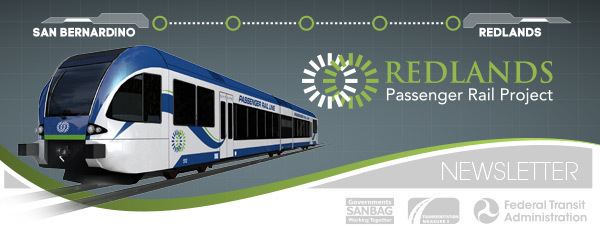Operation will start 2020 (expected) Operator Omnitrans | Host railroads BNSF Number of stations 5 | |
 | ||
Owner San Bernardino Associated Governments Area served Redlands–San Bernardino Locale San Bernardino County, California, United States Website | ||
The Redlands Passenger Rail Project (RPRP) is the temporary name for a proposed passenger rail line in San Bernardino County, California, United States. It is planned to operate between the San Bernardino Transit Center in San Bernardino and the University of Redlands in Redlands, California. Omnitrans branded the service Arrow in November 2016.
Contents
History
Proposals for a rail connection between San Bernardino and Redlands were made as early as the 1990s, with the service originally projected to start in 1995. This date has progressively been delayed to 2013, 2015, and 2018. As of 2015, the line is expected to be complete and operating in 2020.
The 9-mile (14 km) route will use the former Atchison, Topeka and Santa Fe Railway line. While mostly a single track line, 2 miles (3.2 km) of double track will be constructed in the middle of the route to allow vehicles to pass each other. Five initial stops were proposed: three in Redlands and two in San Bernardino, with an initial projected ridership of between 1,600 and 1,800 passengers daily. With connecting service to Metrolink's San Bernardino Line and Omnitrans' sbX bus rapid transit route in San Bernardino, the five new stations would be located at the San Bernardino Transit Center, Waterman Avenue next to the Inland Regional Center, New York Street near Esri headquarters, downtown Redlands next to the Redlands Santa Fe Depot District, and the University of Redlands. Low-volume freight service by BNSF will continue on a portion of the route.
In September 2010, the San Bernardino Associated Governments (SANBAG) considered options that included Metrolink train service, other types of electrified or diesel trains, and buses. In April 2011, SANBAG announced that it had settled on conventional heavy rail equipment for the service. While SANBAG preferred electrified light rail, its $268.1 million cost was over the $250 million limit for the federal Small Starts transit grants that would have been used. The estimated cost of heavy rail service was $198.6 million, which could be paid for using federal transportation grants that were based on population and sales tax revenues. By 2011, the estimated cost of construction had dropped to an estimate of between $130 million and $150 million.
The first contract for the project was awarded on November 2, 2011, by SANBAG to HDR, Inc. for engineering and environmental services. The contract was an amendment to an existing contract for HDR to work on a separate project in the region, the extension of the San Bernardino Line to a new terminus at the San Bernardino Transit Center. Work was initially expected to begin in late 2012 or 2013, with the estimated start of service ranging from 2015 to as late as 2018.
The project has encountered numerous delays, including the government shutdown in October 2013, after which point the construction was slated to begin in fall of 2016. In February 2014, the project was delayed again, when SANBAG stated that "construction is planned to begin in late 2015 with operation in 2018." As of July 2016, construction is planned to begin in 2017 and service in 2020. In July 2016, the project received an additional $8.6 million from the U.S. Department of Transportation in the eighth round of the TIGER grant program.
Future development
The first phase of construction will include replacing all track on the line, rebuilding five bridges, and installing 24 grade crossings. Service was originally planned to begin with refurbished ex-Metrolink rolling stock operating on 30-minute peak period headways and hourly off-peak headways. In 2015, due to community opposition to Metrolink stock, SANBAG chose diesel multiple units to serve as the line's rolling stock. One roundtrip Metrolink train will continue to Downtown Redlands daily along the rehabilitated track.
As of 2011, phase two of the project would see light rail vehicles or diesel multiple units replace the conventional rolling stock, the construction of five more stations, and additional passing sidings to allow 15-minute peak period headways and 30-minute off-peak headways. The estimated construction cost is between $80 million and $100 million for light rail or between $225 million and $300 million for diesel multiple units. Running costs would be between $11 million and $14 million for light rail or between $12 million and $16 million for diesel multiple units. A potential further phase would expand trackage in a loop to Highland and San Bernardino International Airport before returning to downtown San Bernardino. In November 2016, SanBAG officials said the Waterman Avenue station would be built at Tippecanoe Avenue instead, citing higher ridership at the proposed Tippecanoe station due to the Inland Regional Center's heightend security after the San Bernardino shooting as well as zoning modifications near the Waterman stop.
